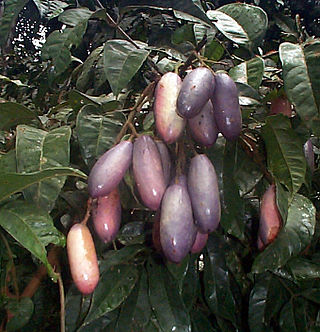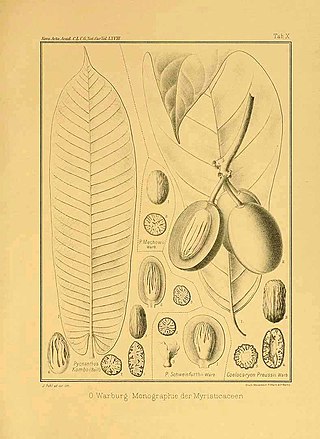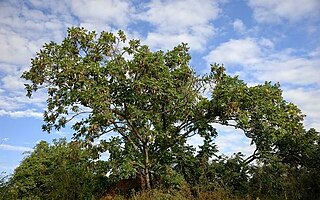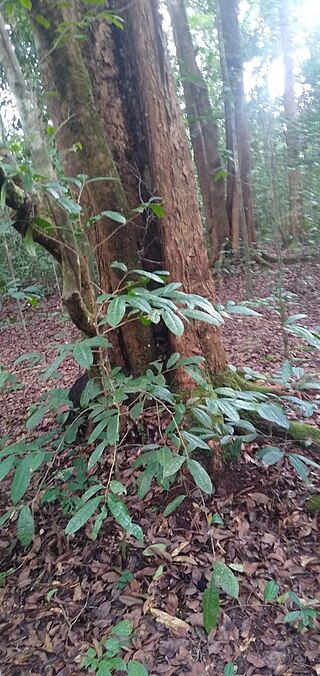
Dacryodes edulis is a fruit tree in the Burseraceae family native to Africa. Its various regional names include safou, plum (Cameroon), atanga, ube, elumi (Nigeria), African pear, bush pear, African plum, nsafu, bush butter tree, or butterfruit.

Anogeissus leiocarpa is a tall deciduous tree native to the savannas of tropical Africa.

Pachyelasma is a genus of flowering plants in the legume subfamily Caesalpinioideae. It contains only one species, Pachyelasmia tessmannii, which is native to central Africa.

Pycnanthus angolensis is a species of tree in the nutmeg family, Myristicaceae. It is native to Tropical Africa. Its English language common names include African nutmeg, false nutmeg, boxboard, and cardboard. In Africa it is widely known as ilomba.
Balanites wilsoniana is a species of fruit-bearing tree from west and central Africa from the caltrop family (Zygophyllaceae).

Hexalobus crispiflorus is a species of plant in the family Annonaceae. It is native to Angola, Benin, Cameroon, Central African Republic, Congo, DR Congo, Gabon, Ghana, Guinea, Guinea-Bissau, Ivory Coast, Liberia, Nigeria, Senegal, Sierra Leone, Sudan, Togo and Zaire. Achille Richard, the French botanist who first formally described the species, named it after its wavy petals of its flowers.

Gilbertiodendron dewevrei is a species of tree in the family Fabaceae, native to tropical rain forests in Central Africa. It is often the dominant tree species of the Guineo-Congolian rainforest. The timber is traded as limbali, and is used for construction, flooring and railway sleepers. It is also used for making boats, furniture, tool handles and joinery and for making charcoal.

Annickia affinis is small to medium sized tree that grows up to 30m tall, it belongs to the Annonaceae family. Also known as the African yellow wood, it is widely used in Central Africa and parts of West Africa in the treatment of various diseases. Both Annickia affinis and Annickia chlorantha are widely studied and sometimes credited with the name Enantia chrlorantha.

Alstonia congensis, is a tree within the Apocynaceae family and one of two African species within the Alstonia genus, the other being the Alstonia boonei De Wild. Both have similar morphological characteristics.

Aganope stuhlmannii is a deciduous tree within the family Fabaceae. It is native to tropical Africa and grows in savanna woodlands.
Duguetia staudtii is a medium-sized evergreen tree within the Annonaceae family. Species is one of four within the genus Duguetia that is native to Africa.
Osodendron altissimum, formerly known as Albizia altissima, is a low branching tree within the Fabaceae family, it grows along river banks in the Lower and Upper Guinean and Congolian forests of west and central Africa.
Bridelia grandis is an evergreen tree within the Euphorbiaceae family, it occurs in secondary forests of Central and West Africa. Its wood is traded under the name Assas, a name it shares with Bridelia micrantha.
Gardenia imperialis is a small to medium sized tree within the Rubiaceae family, it is found in swamp savannahs or forests in Tropical Africa.
Gambeya africana is a medium sized tree within the Sapotaceae family. It is sometimes known as the African Star Apple along with the closely related Gambeya albida. Both species have similar leaf indumentum and are widespread in the Lower and Upper Guinea forest mosaic.
Mammea africana is a medium to large sized tree within the family Calophyllaceae, it is also known as African mammee apple and its timber is traded under the trade name, Oboto. Mammea africana is found in evergreen and semi deciduous forests in West and Central Tropical Africa.

Sacoglottis gabonensis, commonly known as bitterbark tree or cherry mahogany is a medium to large sized evergreen tree within the Humiriaceae family. It is the only species within the genus, Sacoglottis that is native to tropical Africa, another, guianensis Benth. being native to Amazonia. It occurs in rainforests or on sandy soils of Senegal eastwards to Angola in central Africa. It is traded locally and known in some countries under the name Ozouga.
Manilkara obovata is small to large sized evergreen tree within the Sapotaceae family. Its timber is sold under the name Nkunya in Uganda. The species has a wide distribution from Sierra Leone in West Africa moving east to Uganda in Eastern Africa and southwards to Zambia. It is also considered a variable species having different ecotypes.
Entandrophragma angolense, called the tiama, is a tree species with alternate, pinnately compound leaves that are clustered at the ends of branches. It is within the family Meliaceae and has a wide distribution area, occurring in moist semi-deciduous and evergreen forest regions of Tropical Africa from Sierra Leone to Uganda.
Albizia zygia is a fast growing medium-sized tree species within the Fabaceae family that is commonly found in West and Central Africa.










